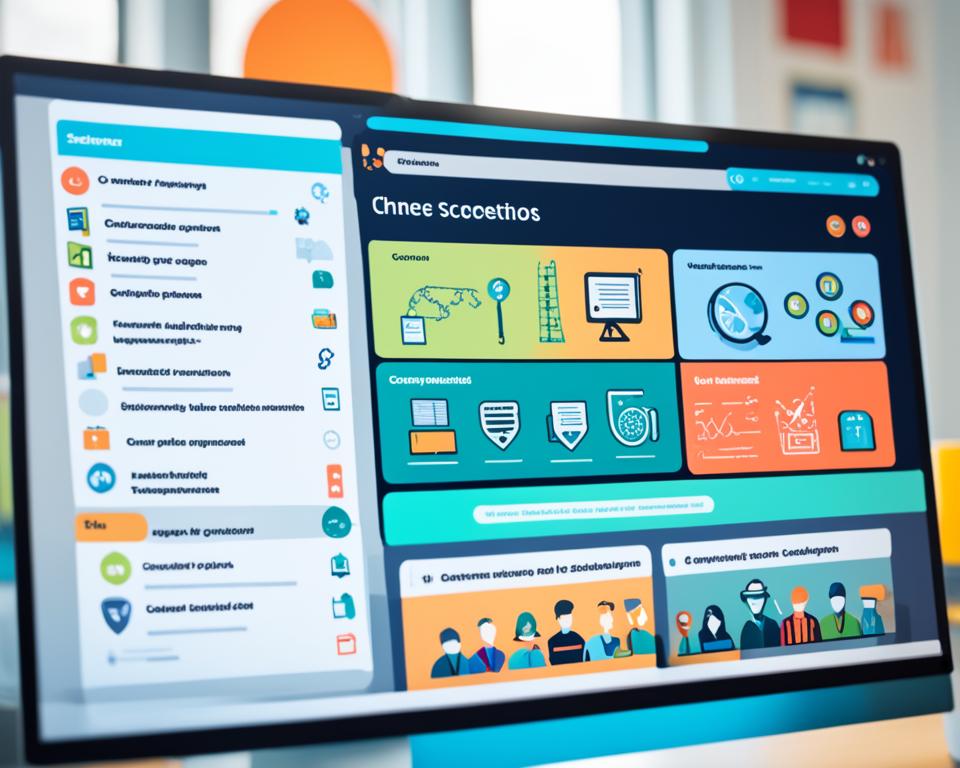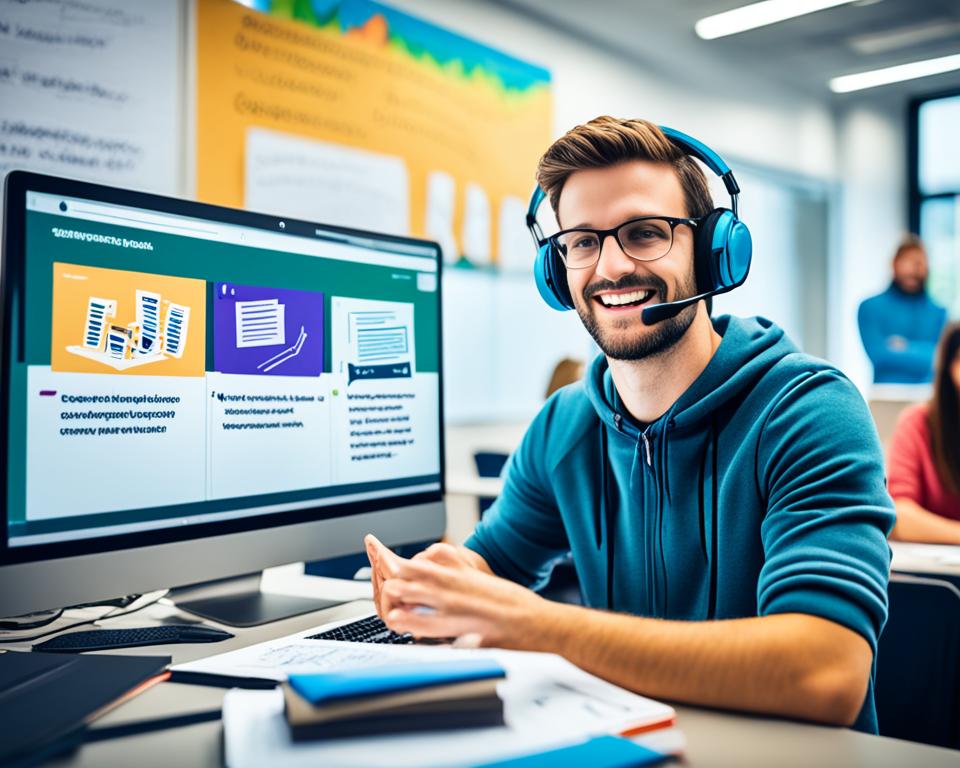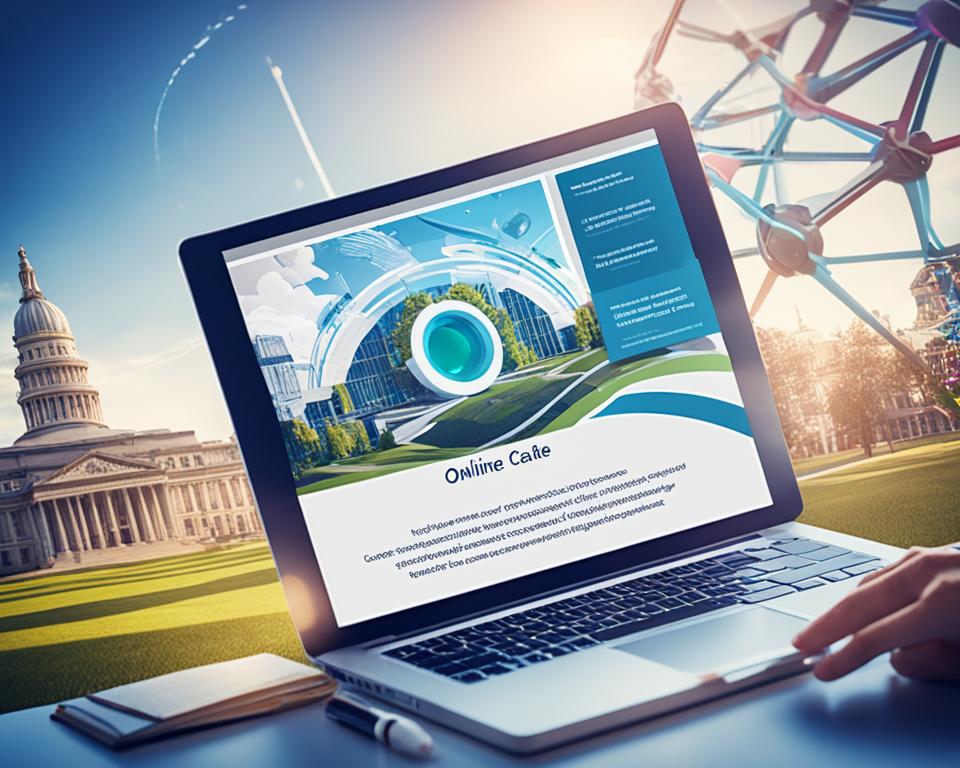Engaging students in an online environment can be a challenging task for educators, but there are effective methods and strategies that can be implemented to create an interactive and dynamic learning experience. By utilizing online student engagement strategies, educators can foster active participation, encourage collaboration, and promote a sense of connection among students.
One of the key best practices for engaging students in an online environment is to initiate interaction and create faculty presence. By actively engaging with students through online communication channels, educators can establish a sense of community, build rapport, and make students feel supported. Providing frequent and interactive feedback on student work is another essential strategy that helps to keep students engaged and motivated. Timely feedback not only helps students track their progress, but also enables them to make improvements and enhances their learning experience.
Hosting virtual office hours is an effective way to create opportunities for real-time communication with students. These sessions provide a platform for students to ask questions, seek clarification, and engage in discussions, fostering a collaborative learning environment. Additionally, using online communication channels for one-on-one text chats allows educators to address individual queries, provide quick answers, and ensure that students feel heard and valued.
Identifying and supporting struggling or disengaged students is crucial for their success in an online learning environment. By regularly monitoring student participation and performance, educators can extend personalized outreach, offering assistance and guidance when needed. Furthermore, allowing for flexibility and leniency in course policies accommodates students’ individual circumstances and promotes a supportive learning environment.
To enhance student engagement further, incorporating multimedia content and interactive elements in online courses can make the learning experience more captivating and interactive. By presenting information in various formats, educators can cater to different learning styles and capture students’ attention and interest.
The best practices for engaging students in an online environment encompass a range of strategies aimed at fostering active participation, building connections, and promoting a sense of belonging. By implementing these practices, educators can create a vibrant and inclusive online learning environment that effectively engages students and supports their academic journey.
Key Takeaways:
- Initiate interaction and create faculty presence to establish a sense of community and support.
- Provide frequent and interactive feedback to help students track their progress and improve their work.
- Host virtual office hours to facilitate real-time communication and foster collaboration.
- Utilize online communication channels for one-on-one text chats to address student queries and concerns.
- Identify and support struggling or disengaged students through personalized outreach.
Initiate Interaction and Create Faculty Presence
In order to engage students in an online environment, educators must take proactive measures to initiate interaction and create a sense of faculty presence. Establishing a connection with students is crucial for fostering engagement and creating a supportive learning environment.
Here are some effective strategies for initiating interaction and creating faculty presence:
- Post information about yourself: Sharing a brief bio or a short video introduction can help students get to know you better and feel more connected to their instructor.
- Develop a communication plan: Outline your expectations for communication and set a clear schedule for responding to student queries. This helps create a sense of structure and establishes regular avenues for interaction.
- Provide frequent and interactive feedback: Regularly review and provide feedback on student work, encouraging active participation and growth. Consider using tools that enable audio or video feedback to enhance the interactive experience.
- Host virtual office hours: Dedicate specific time slots for students to engage with you in real-time. Encourage open discussions, address questions, and provide guidance. Virtual office hours can be conducted through video conferencing platforms or online chat rooms.
- Utilize online communication channels: Leverage various online communication channels, such as messaging platforms, discussion forums, or social media groups, to facilitate one-on-one text chats with students. These channels provide opportunities for quick and direct interaction, allowing for immediate support and guidance.
By implementing these strategies, educators can create an engaging and interactive online learning experience while nurturing a sense of faculty presence that supports students’ academic success.
Provide Frequent and Interactive Feedback on Student Work
When it comes to engaging students in an online environment, providing frequent and interactive feedback on their work plays a vital role. It not only helps students track their progress but also motivates them to continuously improve their performance. Educators should aim to grade papers within one week of students submitting assignments, ensuring timely feedback that enables students to make necessary adjustments and learn from their mistakes.
By offering feedback that is meaningful and actionable, educators can guide students towards achieving their learning objectives. This can be accomplished through various online platforms and tools, such as learning management systems, that allow for efficient grading and feedback delivery. These tools provide a convenient way to assess student work, offer constructive comments, and engage in meaningful dialogue with students.
Interactive feedback goes beyond simply pointing out errors or areas of improvement. It involves providing specific guidance and suggestions for further development, fostering a constructive learning environment. Educators can encourage students to reflect on their work, ask questions, and seek clarification, leading to deeper understanding and active engagement in the learning process.
Additionally, interactive feedback can be facilitated through the use of multimedia elements, such as audio or video recordings, which allow for a more personalized and dynamic feedback experience. This type of feedback enhances student’s understanding and retention by providing a multi-sensory learning experience.
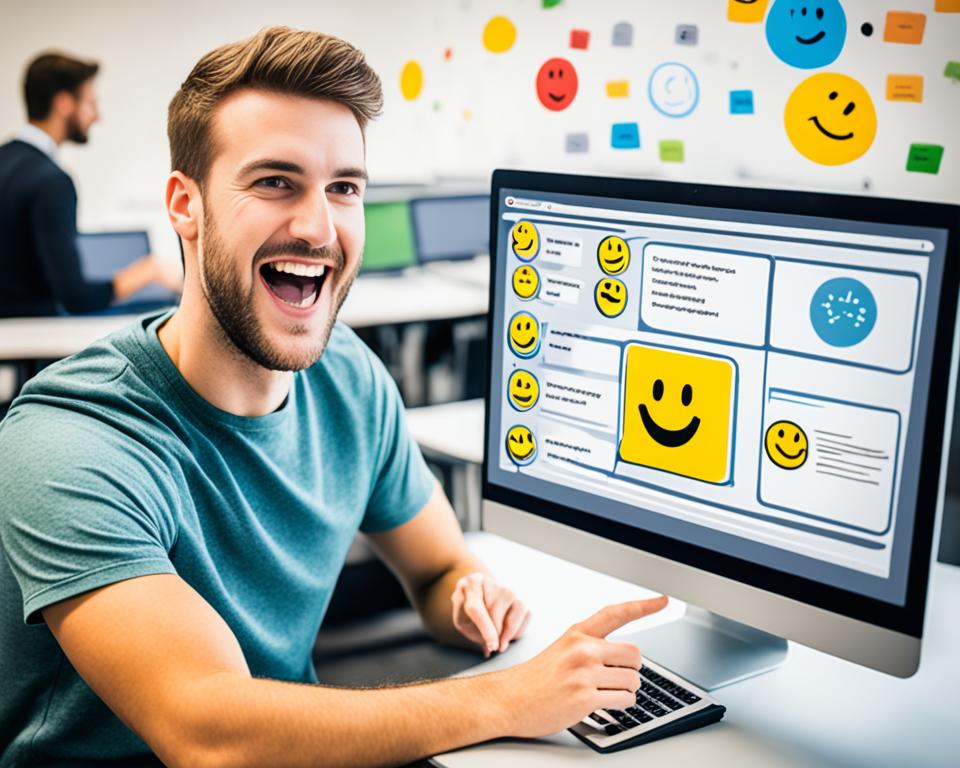
| Benefits of Frequent and Interactive Feedback | Examples |
|---|---|
| 1. Enhances student learning and understanding | Providing specific comments and suggestions that prompt students to reflect on their work. |
| 2. Promotes student engagement and motivation | Engaging in dialogue with students, addressing their questions and concerns throughout the learning process. |
| 3. Increases student progress tracking | Using online platforms to record and track students’ performance over time, allowing for better monitoring of their progress. |
| 4. Encourages self-reflection and growth mindset | Guiding students towards self-evaluation, helping them develop a growth mindset and take ownership of their learning. |
Host Virtual Office Hours
Hosting virtual office hours is an effective way to engage students in an online environment. These sessions provide opportunities for students to talk to educators in real time and ask questions or seek clarification on course materials. To make these sessions more engaging, educators can start with icebreaker activities to create a relaxed and comfortable atmosphere. Virtual office hours can be conducted through video conferencing platforms or other communication tools that allow for face-to-face interaction.
Benefits of Virtual Office Hours:
- Real-time communication: Students can interact with educators and receive immediate responses, fostering a sense of connection and support.
- Opportunity for clarification: Students can seek clarification on course content, assignments, or any areas they may be struggling with.
- Individual attention: Virtual office hours provide dedicated time for one-on-one interactions, allowing educators to address specific student concerns or challenges.
- Flexible scheduling: Virtual office hours can be scheduled at convenient times for both educators and students, accommodating diverse schedules.
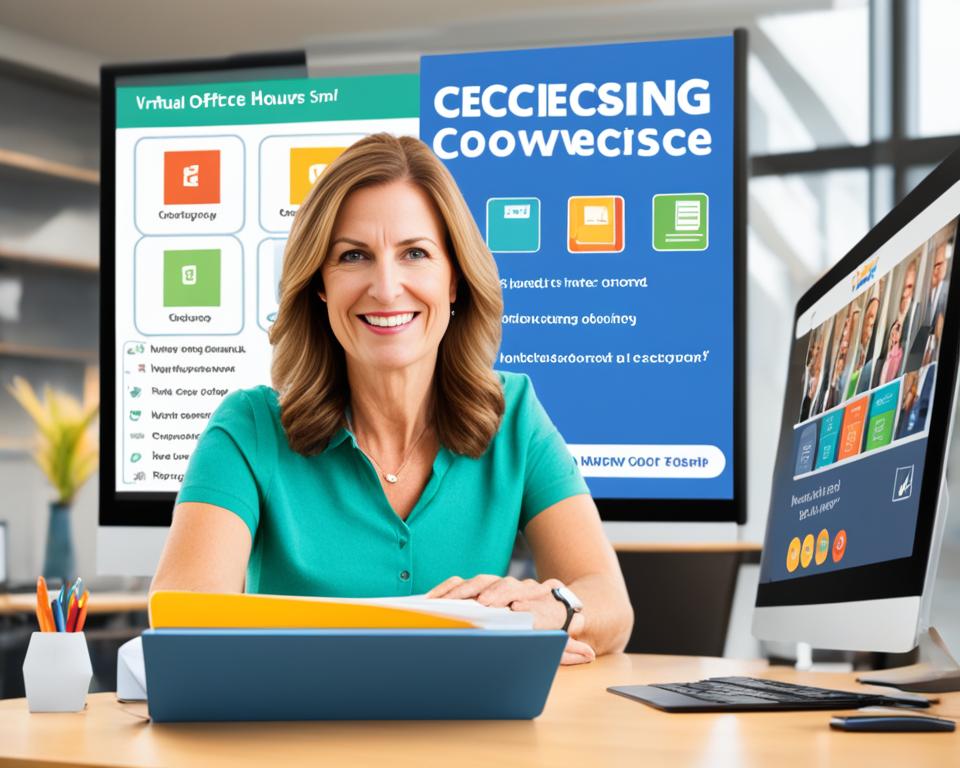
“Virtual office hours provide a valuable opportunity for students to connect with educators on a personal level and receive individualized support during their online learning journey.” – Dr. Rachel Thompson, Online Learning Expert
By incorporating virtual office hours into their online teaching practices, educators can bridge the gap between physical classrooms and remote learning environments. These sessions not only enhance student engagement but also create a sense of community and collaboration within the online classroom. Through real-time communication and personalized interactions, students can feel supported, motivated, and connected to their educators and peers.
Use Online Communication Channels for One-on-One Text Chats
Engaging students in an online environment requires effective communication strategies. One-on-one text chats through online communication channels offer a convenient and efficient way to interact with students and address their questions or concerns. This approach fosters a supportive learning environment and helps to reduce students’ anxiety about the course.
By utilizing messaging platforms or discussion forums, educators can provide quick answers to student questions, ensuring timely responses and keeping students engaged. This method allows for direct communication, allowing educators to offer personalized guidance and support to each student. The one-on-one nature of these text chats helps to establish a sense of connection and ensures that students feel heard and valued.
In addition to quick response times, one-on-one text chats offer a convenient and flexible mode of communication for both educators and students. Students can engage in discussions and seek clarification on course materials at their own pace, without the need for scheduling appointments or joining virtual meetings. This flexibility promotes active learning and encourages students to take initiative in their education.
Here are some benefits of using online communication channels for one-on-one text chats:
- Convenience: Students can reach out to educators and ask questions at any time, eliminating barriers to communication and ensuring that queries are addressed promptly.
- Personalization: Educators can tailor their responses to each student’s specific needs, providing targeted guidance and support.
- Engagement: By offering a direct and interactive communication channel, educators can promote active engagement and create a sense of community in the online learning environment.
- Timeliness: Educators can provide quick answers and clarify any misconceptions, allowing students to proceed with their coursework without delay.
- Accessibility: Text chats can be accessed from various devices, making it easy for students to participate and stay connected.
By incorporating one-on-one text chats through online communication channels, educators can enhance student engagement and create a supportive learning experience. This approach encourages active participation, fosters a sense of community, and helps students succeed in their online studies.
| Benefits of Using Online Communication Channels for One-on-One Text Chats |
|---|
| Convenience |
| Personalization |
| Engagement |
| Timeliness |
| Accessibility |

Identify and Support Struggling or Disengaged Students
In an online learning environment, it is crucial for educators to identify and support students who may be struggling or disengaged. By monitoring their participation and performance, educators can proactively intervene and offer personalized outreach to help them regain motivation and focus.
One effective way to identify struggling or disengaged students is by closely monitoring their participation in online discussions or activities. Lack of engagement or infrequent contributions may indicate that a student is struggling. Additionally, regularly reviewing their performance in assessments or assignments can provide insights into their level of understanding and engagement.
Once struggling students have been identified, personalized outreach becomes essential. Educators can reach out to these students individually to check in on their progress, address any challenges they may be facing, and offer support and encouragement. By showing genuine concern and providing assistance, educators can demonstrate their commitment to student success and foster a supportive learning environment.
Personalized messaging is a valuable tool for reaching out to struggling students. Sending messages with a supportive tone, such as “How’s it going?” or “Is there anything I can help you with?”, can make students feel valued and encourage them to share their challenges. Virtual meetings or one-on-one video conferences can also be set up to provide a more personal and interactive avenue for discussing concerns and offering guidance.
Here’s an example of how personalized messaging can be used to engage struggling students:
“Hi [Student Name], I noticed that your participation in the discussion forums has decreased recently. Is there anything I can do to support you? Let’s schedule a virtual meeting so we can discuss any challenges you may be facing. Remember, I’m here to help you succeed!”
By implementing personalized outreach strategies, educators can demonstrate their commitment to supporting struggling and disengaged students, empowering them to overcome obstacles and succeed in their online learning journey.
| Strategies to Identify and Support Struggling Students | Benefits |
|---|---|
| Monitor participation and performance | – Early identification of struggling students – Insight into engagement levels |
| Offer personalized outreach | – Address student challenges – Provide individualized support |
| Utilize personalized messaging | – Make students feel valued and supported – Encourage open communication |
| Arrange virtual meetings | – Foster personal connections – Provide real-time guidance |
Allow for Flexibility and Leniency
In an online environment, educators should establish clear expectations and course policies while also recognizing the importance of flexibility and leniency. By incorporating these elements into their teaching approach, educators can create a supportive and inclusive learning environment that promotes engagement and allows students to thrive.
Flexibility in Course Policies
Flexibility in course policies is essential in an online learning setting, where students may face unique challenges and circumstances. By offering options such as extended deadlines or alternative assessment methods, educators can accommodate individual needs and ensure that students have a fair opportunity to succeed.
Alternative Assessments
Alternative assessments provide students with diverse ways to demonstrate their understanding and mastery of the subject matter. These assessments can include projects, presentations, or interactive assignments that align with the learning objectives of the course. By incorporating alternative assessments, educators can foster creativity and engagement among students, enabling them to showcase their knowledge in different ways.
Extension Opportunities
Providing extension opportunities allows students to manage their time effectively and overcome any unexpected challenges they may face. By offering extensions for assignments or exams, educators acknowledge that students may have legitimate reasons for needing additional time and support. This approach demonstrates empathy and encourages students to prioritize their learning without compromising their overall well-being.
“Allowing for flexibility and leniency in course policies demonstrates a commitment to student success and well-being. By providing alternative assessments and extension opportunities, educators empower students to take ownership of their learning and strive for excellence.”
By embracing flexibility and leniency in their online courses, educators can create an environment that fosters student engagement, motivation, and overall success. This approach acknowledges the unique challenges students face and ensures that they have the opportunity to thrive in their learning journey.
Benefits of Flexibility and Leniency in Online Learning
| Benefits | Description |
|---|---|
| Increased student satisfaction | Students feel supported and valued when their individual circumstances are considered. |
| Promotes student well-being | Flexibility and leniency help students manage stress and maintain a healthy work-life balance. |
| Enhanced student engagement | Alternative assessments and extended deadlines encourage active participation and investment in the learning process. |
| Improved learning outcomes | By accommodating individual needs, students can fully focus on their learning and achieve their academic goals. |
| Fosters student responsibility | Flexibility and leniency empower students to take ownership of their learning and develop crucial time management skills. |
Incorporate Multimedia Content and Interactive Elements
Enhancing student engagement in an online environment can be achieved by incorporating multimedia content and interactive elements into the teaching process. By using a variety of formats and providing opportunities for student interaction, educators can create a dynamic and immersive online learning experience.
One effective way to integrate multimedia content is through the use of videos. Educational videos can be used to present complex concepts in a visually appealing and easily understandable manner. By incorporating visuals, animations, and real-life examples, videos capture students’ attention and facilitate comprehension.
Podcasts are another valuable tool for incorporating multimedia content. They offer an audio-based learning experience that is convenient for students to access and engage with. Podcasts can be used to provide additional explanations, interviews with experts, or discussions on relevant topics, allowing students to deepen their understanding and engage with the material in a unique way.
Infographics are visual representations of complex information that can be easily understood and remembered. They can be used to summarize key concepts, present data, or illustrate processes. Infographics are particularly helpful for visual learners and those who prefer a more concise and graphical approach to learning.
Interactive elements, such as quizzes, games, and simulations, can further enhance the online learning experience. These elements provide opportunities for students to actively engage with the material, apply their knowledge, and receive immediate feedback. By incorporating interactive elements, educators make learning a more participatory and enjoyable process.
By incorporating multimedia content and interactive elements, educators can cater to different learning styles and capture students’ attention and interest. This approach creates a more engaging and immersive online learning experience, ultimately facilitating better student understanding and retention of the material.
Conclusion
Engaging students in online learning requires the implementation of innovative teaching strategies that promote active learning and interaction. By incorporating strategies such as gamification, collaborative learning, personalized learning, flipped classrooms, and interactive assessments, educators can create a more engaging and interactive online learning experience.
Utilizing gamification techniques, such as leaderboards, badges, and rewards, can motivate students to actively participate and progress in their online courses. Collaborative learning activities, such as group projects and discussions, foster interaction and encourage students to learn from each other.
Personalized learning approaches, such as adaptive learning platforms and individualized assignments, cater to students’ unique needs and interests, enhancing their engagement and understanding. Flipped classrooms, where students engage with pre-recorded lectures and participate in interactive activities during class time, promote active learning and deeper understanding of the material.
Finally, incorporating interactive assessments, such as quizzes with immediate feedback and multimedia-rich assignments, keeps students actively engaged in the learning process while allowing educators to assess their progress and provide timely support. By adopting these innovative strategies, online educators can create a dynamic learning environment that fosters engagement, encourages interaction, and helps students achieve their learning goals.
FAQ
What are the best practices for engaging students in an online environment?
There are several best practices for engaging students in an online environment. These include initiating interaction and creating faculty presence, providing frequent and interactive feedback on student work, hosting virtual office hours, using online communication channels for one-on-one text chats, identifying and supporting struggling or disengaged students, allowing for flexibility and leniency, incorporating multimedia content and interactive elements, and implementing innovative teaching strategies for active learning and interaction.
How can educators initiate interaction and create faculty presence in an online environment?
Educators can initiate interaction and create faculty presence in an online environment by posting information about themselves, developing a communication plan, providing frequent and interactive feedback on student work, hosting virtual office hours, and using online communication channels to facilitate one-on-one text chats with students. These strategies establish a presence and support a supportive learning environment.
What is the importance of providing frequent and interactive feedback on student work in an online environment?
Providing frequent and interactive feedback on student work is crucial for student engagement in an online environment. It helps students track their progress, make improvements, and stay motivated. Educators should aim to grade papers within one week of submission and offer meaningful and actionable feedback through online platforms and tools.
How can virtual office hours help in engaging students in an online environment?
Hosting virtual office hours is an effective way to engage students in an online environment. These sessions allow students to ask questions or seek clarification on course materials in real time. By starting with icebreaker activities and using video conferencing platforms, educators can create a relaxed and comfortable atmosphere for engaging discussions.
How can educators use online communication channels for one-on-one text chats with students?
By utilizing online communication channels such as messaging platforms or discussion forums, educators can facilitate one-on-one text chats with students. This provides quick answers to student questions and reduces any anxiety they may have about the course. By offering direct and timely communication, educators can encourage active engagement and address any concerns or challenges that students may be facing.
How can educators identify and support struggling or disengaged students in an online environment?
Educators can identify and support struggling or disengaged students in an online environment by monitoring student participation and performance. They can reach out to students individually to check-in and offer assistance through personalized messaging or virtual meetings. This support helps in re-engaging students and helping them regain motivation and focus.
Why is it important to allow for flexibility and leniency in an online environment?
Allowing for flexibility and leniency in an online environment is important to create a supportive and inclusive learning environment. It includes providing opportunities for extensions or alternative assessments and understanding and accommodating students’ individual circumstances. Flexibility in course policies helps in promoting student engagement and ensuring their success.
How can educators incorporate multimedia content and interactive elements in an online learning experience?
Educators can enhance student engagement by incorporating multimedia content and interactive elements in an online learning experience. This can be done by using videos, podcasts, infographics, and other visual or interactive tools to make the learning experience more dynamic and engaging. By catering to different learning styles and allowing students to interact with the material, educators can capture their attention and interest.
What are some innovative teaching strategies that promote active learning and interaction in an online environment?
Some innovative teaching strategies that promote active learning and interaction in an online environment include gamification, collaborative learning, personalized learning, flipped classrooms, and interactive assessments. These strategies create a more engaging and interactive online learning experience, helping students stay motivated, build connections, and achieve their learning goals.


